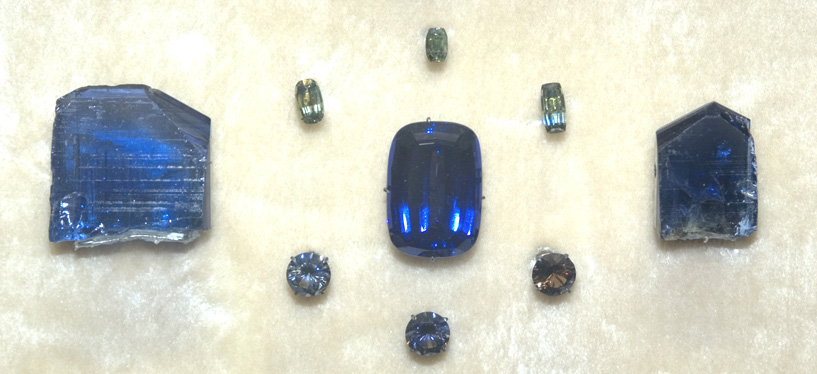
Tanzanite has become very popular (particularly in the USA), with annual sales of around $500 million (Wikipedia.com).
Crystal system: Orthorhombic
Chemical formula/composition: Zoisite's
chemical formula is Ca2Al3Si3O12(OH)
or Ca2AlAl2(SiO4)(Si2O7)O(OH).
Tanzanite is a species of Zoisite and has the same chemistry. It
is a calcium aluminum hydroxy silicate.
Crystal habit: Occurs
as compact masses and Columnar crystals
Hardness: 6.5
Specific gravity: 3.10-3.38
Luster: vitreous to pearly
Toughness: Soft and
liable to damage in rings, not recommended for ultrasonic cleaning.
Cleavage: One perfect cleavage
([001])
Optics: Trichroic with the
following
3 colors; bright blue, violet, and green. Heat treatment reduces
this effect.
Color: Gray, Apple green, Brown,
Blue, Rose red.
Other: U.V. fluorescence: commonly
nonfluorescent, fluoresces blue, green, yellow or red; many opals are
fluorescent
under U.V.
Varieties: Tanzanite
is a variety of Zoisite, other varieties are thulite, a pink variety,
and
anyolite
(really a rock) aka ruby in zoisite.
Localities: Worldwide,
but the most important variety is from Tanzania.
Common simulants
None, but colored glass or the less expensive mineral iolite may be
falsely
substituted.
Synthetics: Synthetics are known
but rare.
Tanzanite is a variety of the mineral zoisite. Tanzanite was discovered in northern Tanzania in 1967, and this is the only significant locality. It was named by Tiffany & Co. It is a form of zoisite that has a purple to blue/violet color. However, it appears that all tanzanite is heat treated from an originally brownish variety of zoisite to obtain the blue color. The treatment is permanent.

Tanzanite has become very popular (particularly in the USA), with
annual
sales of around $500 million (Wikipedia.com).
Even though it is extremely popular, it has disadvantages such as inferior hardness and a strong cleavage. Both of these properties limit tanzanite's use in rings since it can scratch and also split. It is better used in earrings and pendants for which it is well suited. Typically tanzanite is faceted.
Another variety of zoisite is anyolite, more commonly called ruby in zoisite in the trade. This stone is really a mixture of green zoisite and red corundum with some black hornblende to form a metamorphic rock found in Kenya and Tanzania.
Ruby with zoisite is often carved into figures and also makes excellent cabochons and beads.
Thulite is a pink, massive form that is the national stone of
Norway.